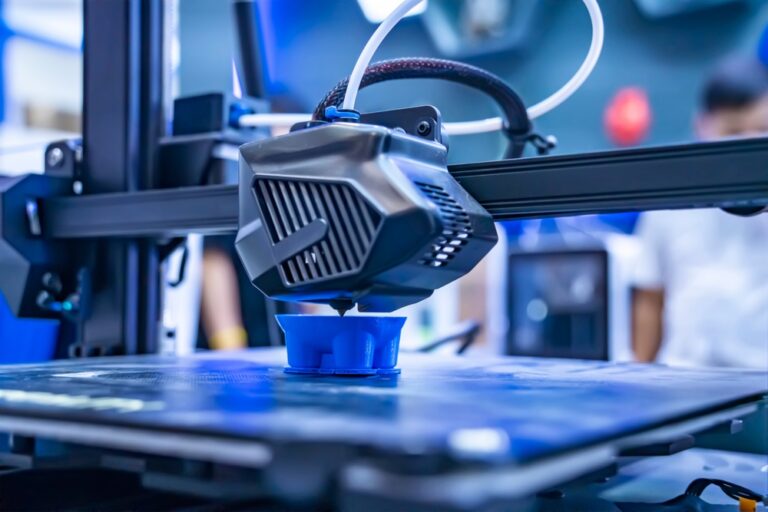In manufacturing, tooling comes in all shapes and sizes — from jigs and fixtures to custom end-of-arm tools (EOAT). Regardless of the tool, one thing is universal: manufacturers want it made quickly, efficiently, and at a reasonable cost. Yet, traditional tooling production often presents roadblocks that slow down workflows, drive up costs, and limit design flexibility. With additive manufacturing (AM), these barriers are removed, giving companies the ability to produce high-quality tools faster, cheaper, and with greater customization.
The High Cost of Traditional Tooling
One of the most pressing challenges in conventional tooling production is cost. While some basic tools can be assembled with off-the-shelf parts, any fixture or jig that requires complexity — whether in shape, function, or fit — can quickly become expensive to design and manufacture. Machining intricate fixtures, like soft jaws or custom assembly aids, often involves significant time and resources, especially when working with metals. CNC mills, while incredibly precise, come with high opportunity costs, as every hour spent machining a custom tool is time taken away from production runs that generate revenue. Additive manufacturing eliminates much of this cost burden. Because 3D printing builds parts layer by layer, creating complex geometries does not add significant time or expense. In fact, additive manufacturing is especially suited for low-volume and custom parts, allowing manufacturers to produce the exact tool they need without overspending.
Long Lead Times and Production Delays
Closely tied to high costs are the long lead times often associated with traditional tooling. Whether producing tools in-house or outsourcing to a machine shop, waiting days or even weeks for a critical fixture to be ready can bring production to a standstill.
For companies trying to stay agile and competitive, these delays are more than just inconvenient — they can have real financial impacts. Commercial 3D printing offers a powerful solution to this problem by drastically reducing lead times. Instead of waiting on a job shop to complete an order, manufacturers can 3D print tools on-site and have them ready for use within hours. Take EOAT, for example. While standard grippers and holders might be available off the shelf, custom EOAT designed for a specific task could take weeks to machine. With a 3D printer in-house, that same part can be printed overnight, getting production back on track without delay.
Breaking Free from Design Constraints
Another critical limitation of traditional machining is the inherent design constraints. Machined parts are often simplified for the sake of manufacturability, meaning engineers are forced to compromise on tool shape, ergonomics, and performance. Sometimes, a tool is made “good enough” because making it perfect would require too much time, money, or effort. Additive manufacturing flips this paradigm on its head. Since 3D printing is not limited by the same physical constraints as subtractive methods, it allows designers to create optimized tools that perfectly fit the task — whether that means adding ergonomic grips, lightweight lattice structures, or conformal features that make the tool easier and safer to use. With AM, “good enough” is no longer the ceiling; it’s possible to create tooling that is ideally suited for both the job and the operator.
Inventory Management Made Simple
Storing large inventories of jigs and fixtures is another costly and inefficient aspect of traditional tooling. Many tools are only used occasionally, yet companies are forced to dedicate storage space and manage these items long-term. Additive manufacturing changes this equation by enabling digital inventory. Instead of keeping physical copies of every tool on hand, companies can store CAD files and simply print the tool when needed. This reduces storage costs and eliminates the need for physical inventory management, while ensuring that tools are always available on demand.
Addressing the Skilled Labor Shortage
Finally, one of the most significant and growing challenges in traditional tooling is the shortage of skilled workers. CNC machinists and other experienced manufacturing technicians are increasingly hard to find, and when they are available, their time is best spent on high-value production work, not one-off tooling. Additive manufacturing offers a way to relieve this pressure. Operating a 3D printer — particularly an FDM system — requires far less specialized training than running a CNC mill, and the learning curve is significantly shorter. This makes it possible to shift some tooling production to less specialized staff, freeing up skilled machinists for tasks that require their expertise. Additionally, once a print job is started, the machine requires little to no supervision, allowing employees to focus on other work while the printer does its job.
A Smarter and Faster Approach to Tooling
Additive manufacturing represents a fundamental shift in how tooling can be approached. By addressing the core challenges of cost, lead time, design flexibility, inventory management, and labor shortages, 3D printing empowers manufacturers to get the tools they need faster, cheaper, and better suited to the job. For companies looking to stay competitive and agile, adopting additive manufacturing for tooling isn’t just an upgrade — it’s a strategic advantage.
Stay in touch to get more updates & news on Vents Buzz!
